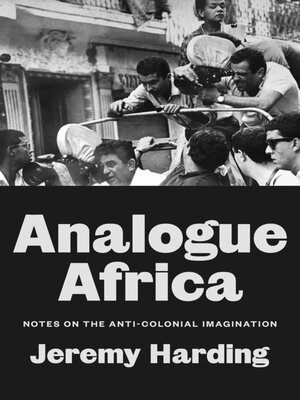
Sign up to save your library
With an OverDrive account, you can save your favorite libraries for at-a-glance information about availability. Find out more about OverDrive accounts.
Find this title in Libby, the library reading app by OverDrive.



Search for a digital library with this title
Title found at these libraries:
| Library Name | Distance |
|---|---|
| Loading... |
A ground-breaking collection of essays on African art, culture and de-colonial imagination
Africa is a convenient abbreviation for 54 countries in which more than a thousand languages are spoken. This book offers a side-long glance, one that complicate the idea of a single continent by picking out specific episodes, specific practices–cinema, art, ethnography and journalism–that rescue us from generalisations. So much of what we understand about these places comes from western media sources and informed by a need to treat Africa as a metaphor.
Analogue Africa excavates the many facets of the anti-colonial imagination: cinema, photography, art and journalism. The book celebrates the ingenuity with which African artists, and a handful of Europeans, have reimagined the colonial encounter and the struggle against white minority rule.
This includes artists, filmmakers and photographers such as John Akomfrah, William Kentridge, Binyavanga Wainaina, Seydou Keïta, Sanlé Sory and Ruth Motau. Harding also looks at the role of western museums, The British Museum, the Musée du quai Branly, Tervuren, that display African art, and what it says about the post colonial imagination.
Africa is a convenient abbreviation for 54 countries in which more than a thousand languages are spoken. This book offers a side-long glance, one that complicate the idea of a single continent by picking out specific episodes, specific practices–cinema, art, ethnography and journalism–that rescue us from generalisations. So much of what we understand about these places comes from western media sources and informed by a need to treat Africa as a metaphor.
Analogue Africa excavates the many facets of the anti-colonial imagination: cinema, photography, art and journalism. The book celebrates the ingenuity with which African artists, and a handful of Europeans, have reimagined the colonial encounter and the struggle against white minority rule.
This includes artists, filmmakers and photographers such as John Akomfrah, William Kentridge, Binyavanga Wainaina, Seydou Keïta, Sanlé Sory and Ruth Motau. Harding also looks at the role of western museums, The British Museum, the Musée du quai Branly, Tervuren, that display African art, and what it says about the post colonial imagination.







